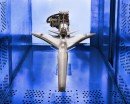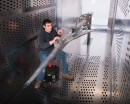With a planned first flight as soon as next year, NASA is speeding the pace of development for the X-59 supersonic research aircraft. Also known as Quiet SuperSonic Technology (QueSST), the machine is supposed to be the one that would make supersonic flight over populated areas possible, including by civilian aircraft.
The only successful civilian supersonic aircraft to fly to date, the Concorde, generated quite the noise when in the air. 90 dB is what measurements read, but because no one is allowed to go supersonic over populated areas, it screamed them all in the vastness of the Atlantic ocean air.
The X-59, although still supersonic, is supposed to breach the sound barrier with just a 60 dB thump, about as much as you get in an average chat with a friend. This incredibly low level of noise is due to a number of technologies that will be deployed on the plane, meant to separate the shocks and expansions of air pressure waves associated with supersonic flight.
One of these technologies is the engine inlet that will feed the General Electric F414 powerplant that will power the thing. Unlike in other aircraft, the inlet, and by extension the engine, is not placed on the bottom of an aircraft, but on top of it, thus the wing can act as a shield and protect the hardware from supersonic shock waves. The goal of the engine inlet is to feed it air in controlled bursts, smooth and slow.
Last week, NASA shared an image (main photo of this piece) of the said air inlet, as it moves to conduct tests of how it is going to work. For now, the hardware is restricted to high-speed wind tunnel testing, but once it gets onto the plane and the whole thing is ready to fly, it will work its magic in the skies over select American cities as its builders are looking to get a look at some data of what they have done.
The X-59, although still supersonic, is supposed to breach the sound barrier with just a 60 dB thump, about as much as you get in an average chat with a friend. This incredibly low level of noise is due to a number of technologies that will be deployed on the plane, meant to separate the shocks and expansions of air pressure waves associated with supersonic flight.
One of these technologies is the engine inlet that will feed the General Electric F414 powerplant that will power the thing. Unlike in other aircraft, the inlet, and by extension the engine, is not placed on the bottom of an aircraft, but on top of it, thus the wing can act as a shield and protect the hardware from supersonic shock waves. The goal of the engine inlet is to feed it air in controlled bursts, smooth and slow.
Last week, NASA shared an image (main photo of this piece) of the said air inlet, as it moves to conduct tests of how it is going to work. For now, the hardware is restricted to high-speed wind tunnel testing, but once it gets onto the plane and the whole thing is ready to fly, it will work its magic in the skies over select American cities as its builders are looking to get a look at some data of what they have done.





